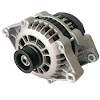Working of D.C Generator
As explained before the D.C generator converts mechanical energy into electrical (D.C) Energy. The generator is usually coupled to a prime-mover. The prime mover may be a diesel/petrol engine, or a turbine depending upon the rating and application of the generator. The prime-mover converts some sort of energy (diesel/petrol/water/steam/gas etc) into mechanical energy. This mechanical energy is supplied to the generator (i.e. generator input).
If the generator is very small for commercial purpose i.e. for a shop or small work shop or cinema etc. the prime-mover is a diesel energy engine. If the generator is very big like in power stations then the prime mover will be a turbine. Again depending upon the resources the turbine may be a water turbine, steam turbine, gas turbine etc.
When the prime-mover output is given to the generator, the generator armature starts rotating. Usually the poles on the yoke are made of permanent magnets. Therefore, the armature conductors cuts the weak magnetic field established by permanent magnets and small amount of e.m.f. is induced in the armature winding according to faradays laws of electromagnetic induction. This induced e.m.f. circulates a small amount of current through the field winding and strengthens the magnetic flux established and hence the induced e.m.f. thus due to the reinforcement of the flux and E.m.f. the generator establishes the rated voltage.
Conversion From AC to
DC by Commutator
Commutator is one of the major rotating parts of a D.C generator. It is mounted on the same shaft side by armature. Armature winding is connected to commutator lugs. Usually the negative half wave of AC generated in armature winding is converted to positive half by commutator (or split-ring) the alternating current induced in armature conductors is made unidirectional in the external load due to rectifying or conversion action of split-ring or comutator.











0 Comments